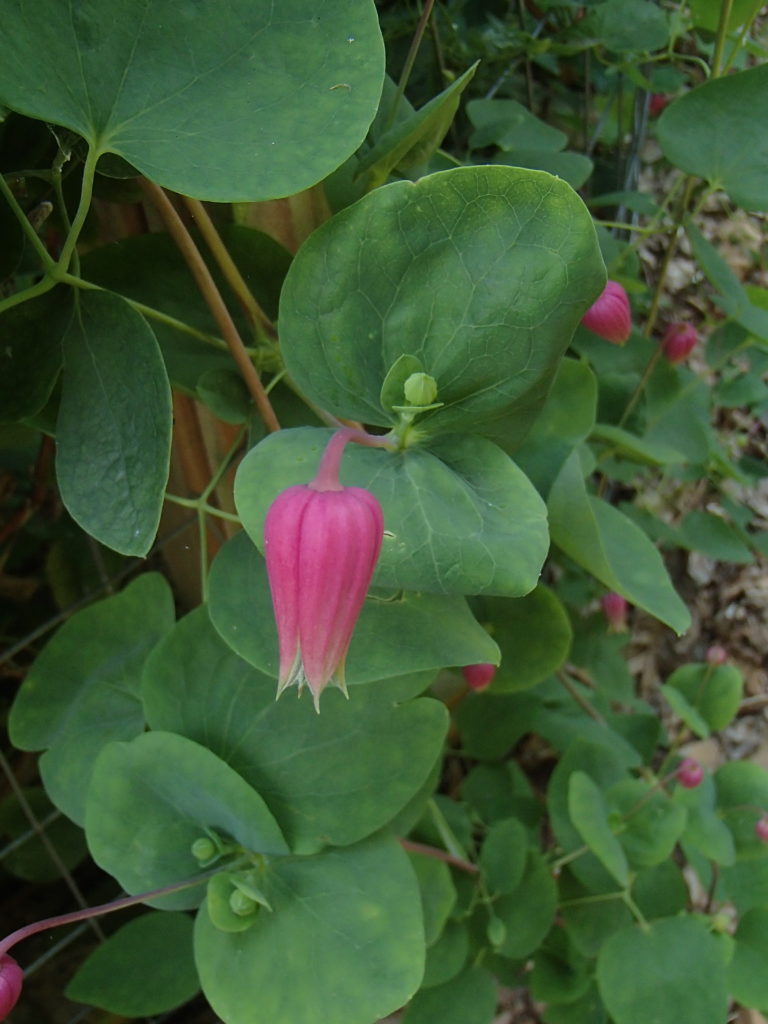Leatherflower, described by Carl Linnaeus in 1753, is a belle of the Southeast. This slender, herbaceous perennial vine is valued for its sheer delicate beauty. The nodding, reddish-purple, bell-shaped flowers are thickly textured and the rosy, recurved petals are cream-colored at the tips and inside. But they do more — the flowers attract hummingbirds, bees and butterflies and then mature to become beautiful, dramatic seed heads for birds to enjoy. In nature, it grows along wood edges and stream banks under tree canopies from Pennsylvania to Missouri and south to Georgia and Mississippi. In the garden, it climbs – by tendrils – to a mere 10 to 12 ft in bright shade with average soil moisture, adaptable and easy to grow. Any stems remaining from the previous season can be cut to the ground, as all the flowering will come on the new growth in late spring and summer. The achenes with their feathery tails extend the attractiveness of the vine into the fall.
NURSERY HOURS
Wednesday: 10-4 Thursday: 10-6 Friday-Saturday: 10-4 Sunday: 12-4
Clematis viorna

Key Info
Scientific Name: Clematis viorna L.
Common Names: Leatherflower, Vasevine, Northern Leatherflower
Family Names: Ranunculaceae (Buttercup Family)
Plant Type: Vine
Moisture Requirement: Medium
Flower Color: Pink/rose
Special Characteristics: Showy fruit, Fall interest, Attracts bees, Attracts Hummingbirds, Attracts birds
Additional Info
Habit: A small, mostly non-woody, herbaceous perennial vine.
Height: up to 12'
Spread: n/a
Soil Conditions: Moist, well-drained soil with a neutral to a slightly alkaline pH.
Leaves: Leaves are alternate, either simple or odd-pinnately compound. Simple leaves and leaflets are lanceolate, 3" long x 2" wide, with entire margins and sometimes with lateral lobes. The major veins of each leaf are parallel.
Flowers (or reproductive structures: Single, bell-shaped, perfect flowers 1" across by 2" long, in various shades of pink, violet to dull purple, with thick, fleshy, reflexed, petal-like sepals (no petals), creamy white interior.
Fruit: Leatherleaf has a large seed head with many individual seeds, each seed attached to a fuzzy plume of a tail for wind distribution.
Natural Distribution: rich woods, thickets
USDA Hardiness Zone: 4 to 9
USDA Wetland Indicator Status in NC: Not availale
Pollination: Bees
Wildlife Connections: Bumblebees pollinate the flowers. Other insects (thrips, midges) feed destructively on the flowers. Butterfly, moth and fly larvae feed on the foliage and stems. The foliage is probably poisonous to mammalian herbivores. All Clematis provide useful cover and nesting habitat for many songbirds in open wooded areas.
Propagation: From seed, by semi-hardwood cuttings, or by layering.
